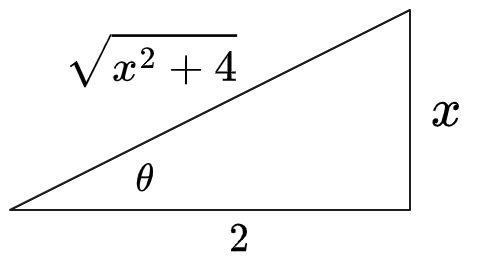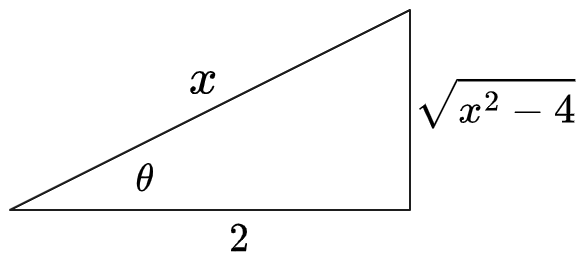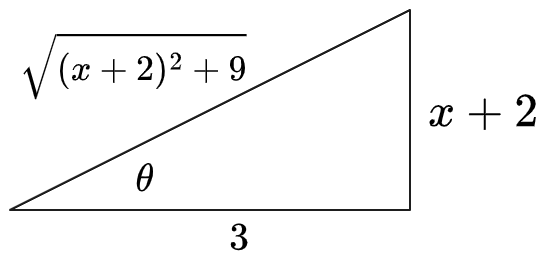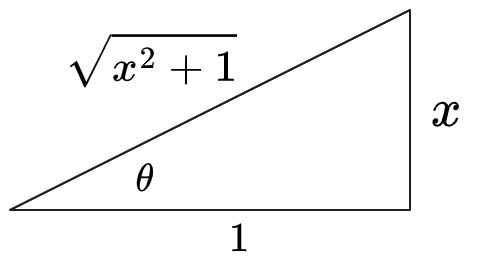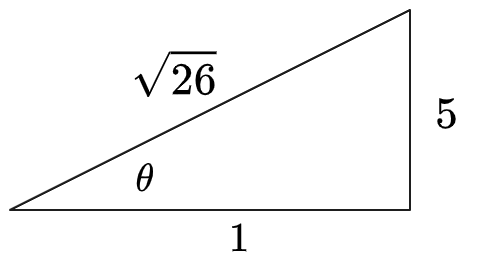Stepwise problems - Thu. 11:59pm
Trig power products
01
01
Somewhat odd power product
Compute the integral:
Solution
01
(1) Notice odd power on
. Swap the even bunch:
(2) Integrate with
-sub setting and thus : Link to original
02
02
Tangent and secant both even
Compute the integral:
Solution
02
(1) Notice
. Therefore integrate with -sub setting and : Link to original
03
03
All even power product
Compute the integral:
Solution
03
(1) Notice all even powers. Use power-to-frequency conversion:
Plug in:
Simplify:
(2) Reduce power again for
: (This is derived from the power-to-frequency formula by changing ‘
’ to ‘ ’ in that formula.)
(3) On the last term, swap even bunch:
Plug all in and obtain:
(4) Integrate the first three terms:
(5) Integrate the last term with
-sub, setting and :
(6) Combine in final result:
Note: It is also possible to rewrite
Link to originalusing trig identities. So, equally valid answers may look different than this.
Trig substitution
04
01
Trig sub
Compute the definite integral:
Solution
04
(1) Substitute
and thus . Adjust the bounds as follows: Rewrite the integral:
(2) Use power-to-frequency conversion:
Note A: Use
Link to original, then and this equals for .
05
02
Trig sub
Compute the integral:
Solution
05
(1) Trig substitution. Notice
, so we should make use of the identity . Pick
and thus . Then:
Plug in:
(We assume that
for the relevant values of .)
(2) Perform integration.
Either recall from memory, or multiply above and below by
, and obtain:
(3) To convert to
we need given that . Draw triangle expressing
:
Therefore
. We already know . Thus:
(4) Simplify with log rules:
Link to original
Regular problems - Sun. 11:59pm
Trig power products
06
04
All odd power product
Compute the integral:
Solution
06
(1) Notice odd power on
. Swap the even bunch:
(2) Perform
-sub setting and thus :
(3) Convert back to
: Link to original
07
05
Tangent and secant mixed parity
Compute the integral:
- (a) Using
. - (b) Using
. Solution
07
(a) Select
and thus :
(b)
(1) Select
and thus :
(3) Swap even bunch using
:
(4) Perform
-sub with and integrate: Link to original
08
06
Power product with negative power
Compute the integral:
Solution
08
(1) Change variable by substituting
and :
(2) Identify
:
(3) Perform
-sub with and thus : Link to original
Trig substitution
09
03
Trig sub
Compute the integral:
Solution
09
(1) Notice
pattern, so we should make use of the identity . Select
and thus . Then: Plug in and simplify:
(We must assume that
for the relevant values of here.)
(2) Use power-to-frequency conversion:
(3) Convert back to terms of
: First draw a triangle expressing
:
Therefore:
For
, use the double-angle identity: Therefore:
Link to original
10
04
Trig sub
Compute the integral:
Hint: complete the square and then substitute.
Link to originalSolution
10
(1) Complete the square:
(2) Substitute
and thus :
(3) Convert back to terms of
: First draw a triangle expressing
:
It follows that
. Then:
Note A: Using log rules, the denominator
Link to originalcan be brought out as which can be “absorbed” into the constant .
11
05
Trig sub
Compute the integral:
Solution
11
(1) Notice
pattern, so we should make use of the identity . Select
and thus . Then:
(2) Convert to
and integrate:
(3) Convert back to terms of
: Draw a triangle expressing
:
Therefore
and . Then: Link to original
12
06
Double sub:
-sub then trig sub Compute the definite integral:
Solution
12
(1) Perform
-sub setting and thus . Adjust the bounds as follows: Therefore:
(2) Notice
pattern, so we should make use of the identity . Select
and thus . Adjust bounds: Therefore:
(3) Integrate from memory or multiplying above and below by
: Link to original
13
07
Trig sub for electric charge
A charged wire lies on the
-axis running from to . The electric field at the point is given by: Find the numerical value of
assuming and and and . Solution
13
(1) Take out constants and insert given values:
(2) Notice
pattern, so we should make use of the identity . Select
and thus . Then: Adjust bounds:
Then:
(3) Integrate:
(4) Compute
: Draw a triangle expressing
:
Therefore
. Then: Link to original
